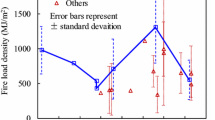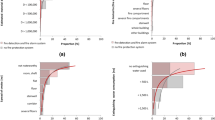Abstract
Fire simulations and sensors are widely used in building fires, various data such as temperature, CO and CO2 concentration, visibility can be obtained by sensors and sensor-based simulation. It is important to generate a risk map based on such data so that we can use it to estimate safety of the building. In this paper, we propose a method to generate a dynamical, integrated risk map using sensor readings in a building fire. Such risk evaluation model is developed using similarity comparison between the space state and dangerous state by a likelihood distance calculating and data grouping from a two-step cluster method. The risk evaluation model considers the integrated influence on the occupants in the zone from high temperature, lack of oxygen, toxic and harmful gases and shows the relative fire risk map at certain time. Based on the simulation study, it is proved that multi-factor fire risk analysis would be more objective and accurate than single factor and two-factor risk analysis and the fire risk evaluation model can generate a risk map and provide the classification information and the whole building risk statistic results to support evacuation command and control.
Similar content being viewed by others
References
Cooper L Y, Stroup D W. ASET-A computer program for calculation available safety egress time. Fire Saf J, 1985, 9(1): 29–45
Keanea R E, Drurya S A, Karaua E C, et al. A method for mapping fire hazard and risk across multiple scales and its application in fire management. Ecol Model, 2010, 221(1): 2–18
Hanea D, Ale B. Risk of human fatality in building fires: A decision tool using Bayesian networks. Fire Saf J, 2009, 7(44): 704–710
Hasofer A M, Odigie D O. Stochastic modeling for occupant safety in a building fire. Fire Saf J, 2001, 36(3): 269–289
Kobes M, Helsloot I, Vries B D, et al. Building safety and human behaviour in fire: A literature review. Fire Saf J, 2010, 2(45): 1–11
Chuvieco E, Aguado I, Yebra M, et al. Development of a framework for fire risk assessment using remote sensing and geographic information system technologies. Ecol Model, 2010, 2(221): 46–58
Xiao Z W. Research on the methods for constructing the information model in information retrieval system (in Chinese). Sci/Tech Information Developme & Economy, 2005, 15(8): 74–76
Chen X Z, Wen J P, Chen N. A new AC sampling algorithm using wavelet denoising to measure the parameters of power network (in chinese). J Sensors and Actuators, 2007, 20(3): 640–643
Iliadis L S, Vangeloudh M, Spartalis S. An intelligent system employing an enhanced fuzzy c-means clustering model: Application in the case of forest fires. Computer Electron Agric, 2010, 70(2): 276p–284
Zhu Y C. Application of two step cluster model (in Chinese). Market Res, 2005, 1: 40–42
Bacher J, Wenzig K, Volge M. Spss twostep cluster-a first evaluation. Proceedings of RC33 Sixth International Conference on Social Science Methodology, Amsterdam, The Netherlands, 2004, 8: 16–20
Yan G Q, Liu Z X, Shen C, et al. Solar wind entry via flux tube into magnetosphere observed by cluster measurements at dayside magnetopause during southward IMF. Sci China Ser E-Tech Sci, 2009, 52(7): 2104–2111
Zhou S H, Fu L, Liang B L. Clustering analysis of ancient celadon based on SOM neural network. Sci China Ser E-Tech Sci, 2008, 51(7): 999–1007
Chu G Q, Sun J H. Decision analysis on fire safety design based on evaluating building fire risk to life. Safety Sci, 2008, 46(7): 1125–1136
Author information
Authors and Affiliations
Corresponding author
Rights and permissions
About this article
Cite this article
Chu, Y., Zhang, H., Shen, S. et al. Development of a model to generate a risk map in a building fire. Sci. China Technol. Sci. 53, 2739–2747 (2010). https://doi.org/10.1007/s11431-010-4063-8
Received:
Accepted:
Published:
Issue Date:
DOI: https://doi.org/10.1007/s11431-010-4063-8




